What Kind Of Animal Live In The Desert
11 weird desert animals
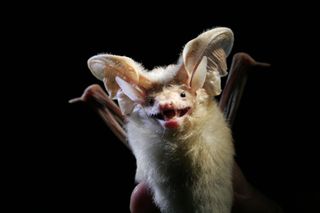
Deserts are not easy places to call dwelling. Broiling in the twenty-four hour period, frigid at night, and lacking aplenty h2o, these landscapes test their inhabitants. The creatures that call deserts home take adaptations to help them survive and thrive in these harsh conditions. Many of these creatures never need to drink and have peel or scales that enable them to hoard what little water they crave; some have evolved to move and be active solely at night to avert the punishing lord's day. Here are xi of the strangest animals constitute in deserts effectually the world.
Fennec trick
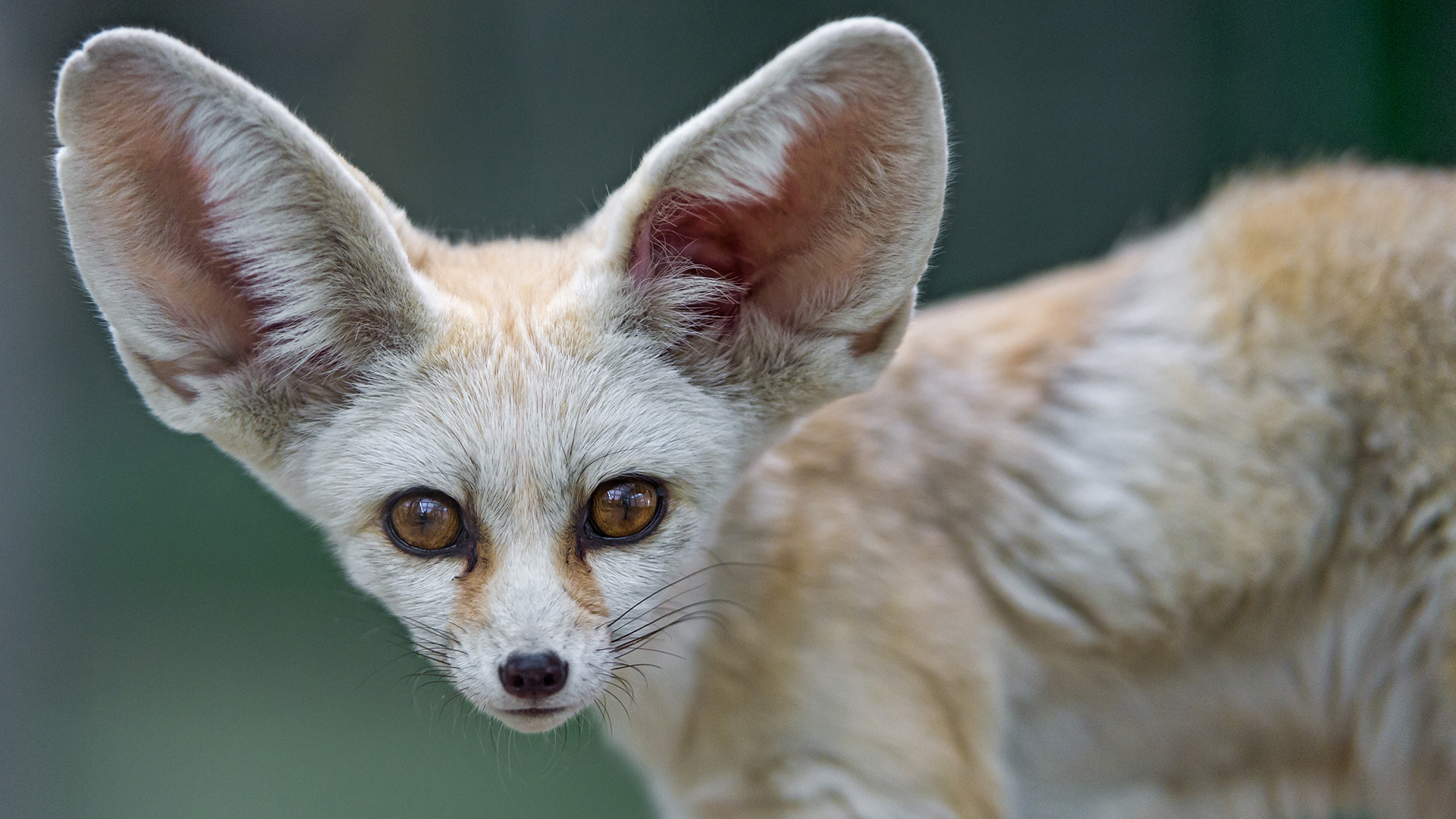
Desert animals don't become much cuter than fennec foxes (Vulpes zerda). These teeny canids are smaller than domestic cats, measuring 14 to 16 inches (35.6 to forty.6 centimeters) long, non including their tails, but they sport enormous ears that can grow to be 4 to 6 inches (x.two to 15.2 cm) long. These ears help the foxes shed estrus and listen for prey under the sand. When the foxes catch the sound of rodents, insects or other small-scale animals they predate, they employ all 4 paws to dig out their quarry in a shower of sand, co-ordinate to the Smithsonian National Zoo.
Fennec foxes are well-adapted for life in African and Arabian deserts. Their pale fur camouflages them against the sand; it also grows on the bottoms of their feet to give them traction while running in the sand and protects their feet from the hot desert surface. When air temperatures rise, the foxes can pant up to 690 times per minute to cool down. Fennec foxes likewise dig elaborate burrows to escape the sun in the hottest part of the day.
Screaming hairy armadillo
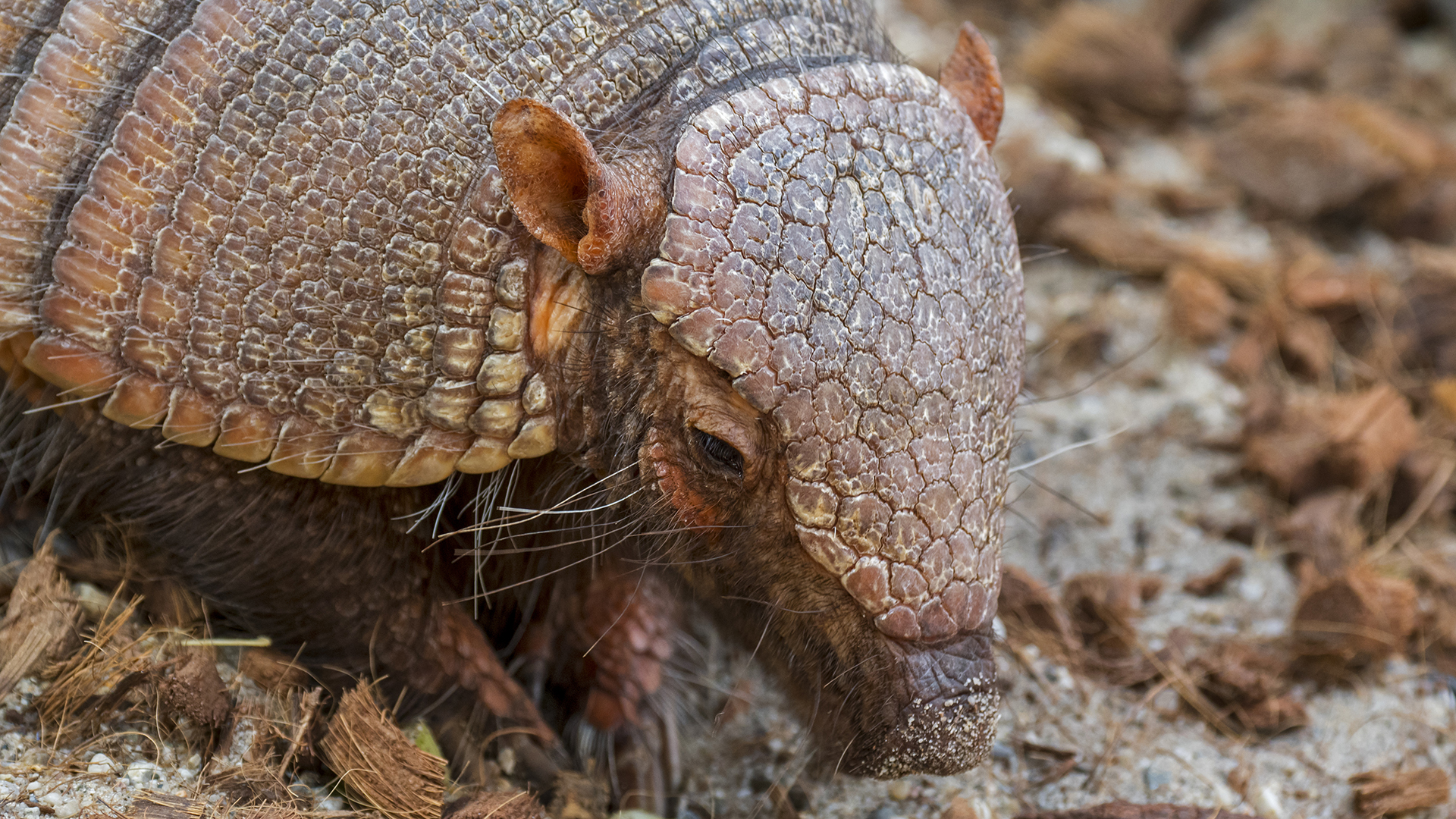
Possibly less cute than fennec foxes — but no less well-adjusted to their desert environs — are screaming hairy armadillos (Chaetophractus vellerosus). These armadillos really practice scream; when threatened, they make a terrible cry that sounds similar to the wails of a newborn human being babe. Enquiry published in 2019 (opens in new tab) suggests that these screams are designed to startle predators, or to attract other predators to the scene, maybe distracting an attacker and enabling the armadillo to go away.
Screaming hairy armadillos are minor, weighing only 1.9 pounds (0.86 kilograms). They live in the Monte desert of Argentine republic, Bolivia and Paraguay, preferring spots with loose, sandy soil where they tin can dig burrows, co-ordinate to the Smithsonian National Zoo. The armadillos rarely need to potable. Their kidneys are highly efficient, and they get well-nigh of the h2o they need from the plants they eat. Information technology's a waste not, desire not environment in the desert, so screaming hairy armadillos are opportunistic eaters — they also consume insects and small animals such every bit lizards and rodents.
Hairy desert scorpion
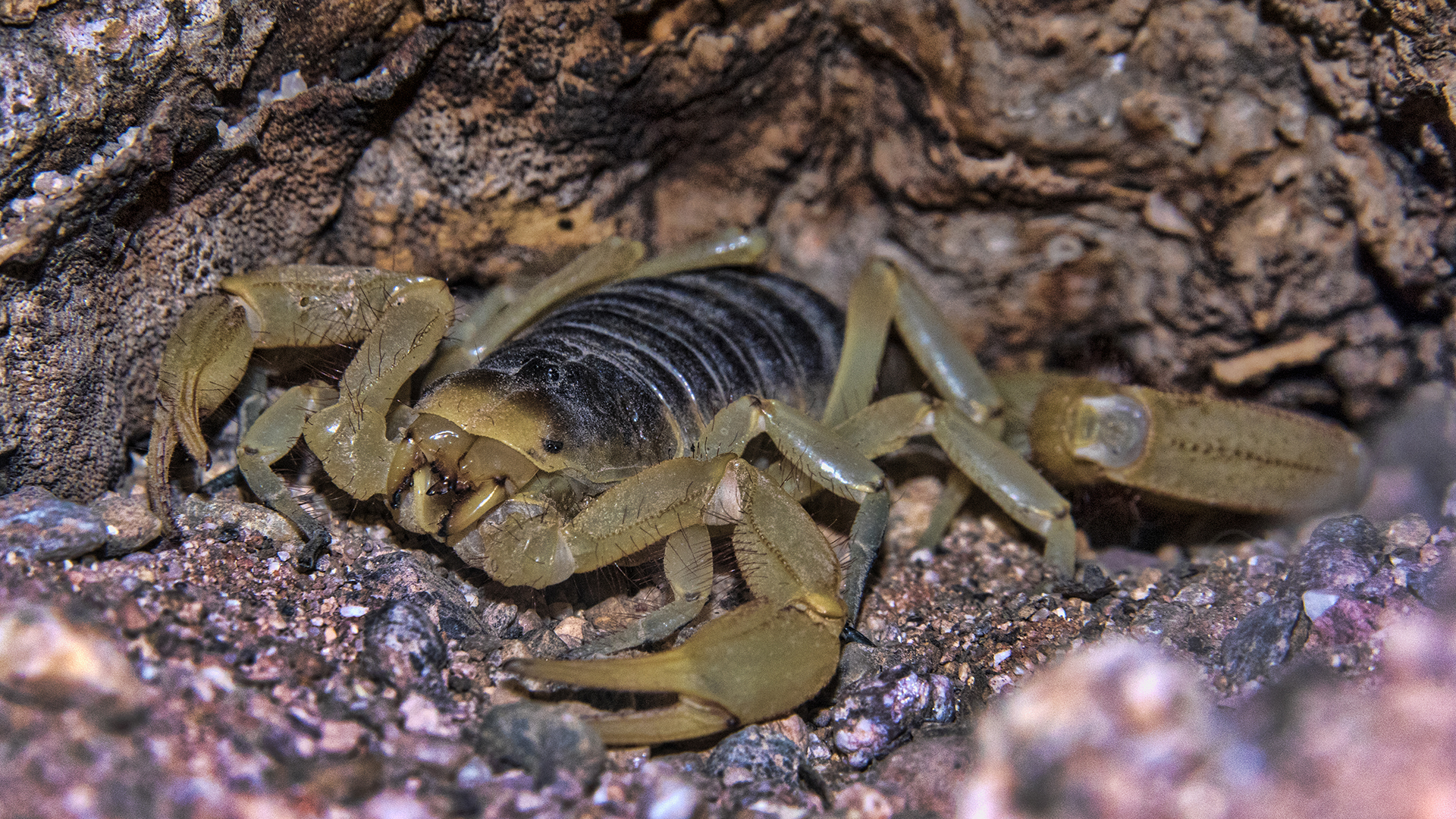
Amid the many scorpion species that call deserts dwelling, the hairy desert scorpion (Hadrurus arizonensis) is a standout. These sorpions can measure between 4 and 7 inches (10.two to 17.8 cm) long, according to Utah'south Hogle Zoo, making them North America's largest scorpions. Though they are a drab olive-green color, hairy desert scorpions fluoresce under ultraviolet (UV) light. No ane knows exactly why scorpions fluoresce, but the best way to find these shy nocturnal predators is to have a UV low-cal into the desert on a summer dark, when they tend to exist well-nigh active.
Hairy desert scorpions are found in North America's Sonoran and Mojave deserts, as well as in Nevada and Utah. When looking to mate, male and female hairy desert scorpions lock pincers in a mating dance that looks more like a wrestling match. In fact, if the male does not flee chop-chop subsequently depositing his sperm, he might discover himself condign his mate's next meal.
Females gestate their young for six to 12 months, alive-birthing up to 35 babies that piggyback on their mother'south carapace until they're large enough to hunt on their own. Fortunately for humans, desert hairy scorpions would rather flee than sting, and their venom is relatively weak. For most people, the sting is similar to a bee's sting.
Harris's Hawk
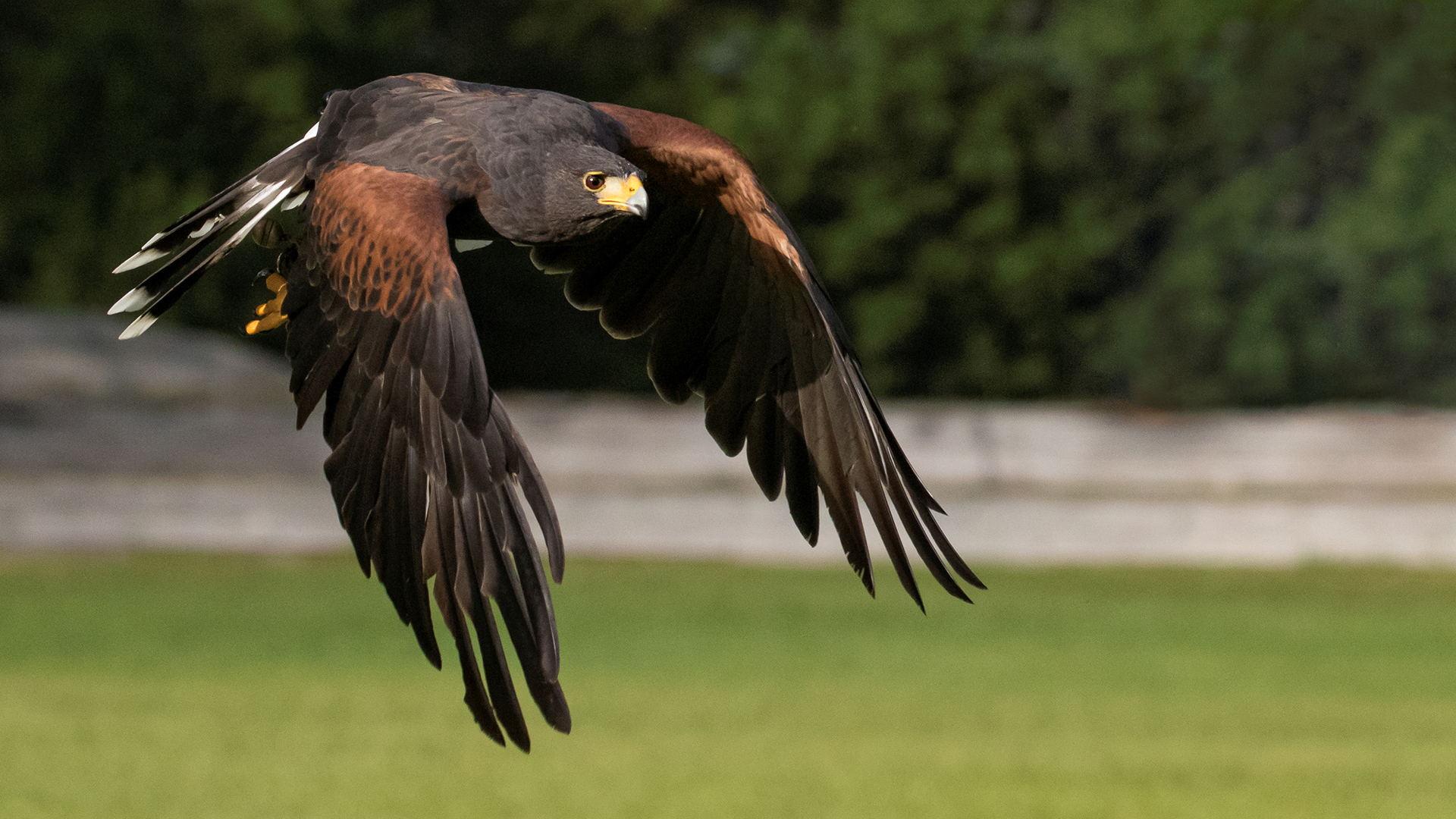
Harris'south hawks (Parabuteo unicinctus) are oddities in the falcon world. These impressive blood-red-winged raptors sometimes hunt in packs, working together to pursue their prey around bushes, thickets and the saguaro cactuses of Arizona's Sonoran desert. The birds swallow lizards, other birds and small desert mammals such as kangaroo rats and ground squirrels. When they catch large prey, they'll share the meat with their boyfriend hunters, according to the conservation nonprofit Audubon.
These birds also often work in groups to raise their young. 2 males may mate with a single female, and the trio work together peacefully to raise whatsoever ensuing hatchlings. Hawk siblings aid each other, also; an older brood from earlier in the season may stick around to bring nutrient to younger broods.
Desert ironclad beetle
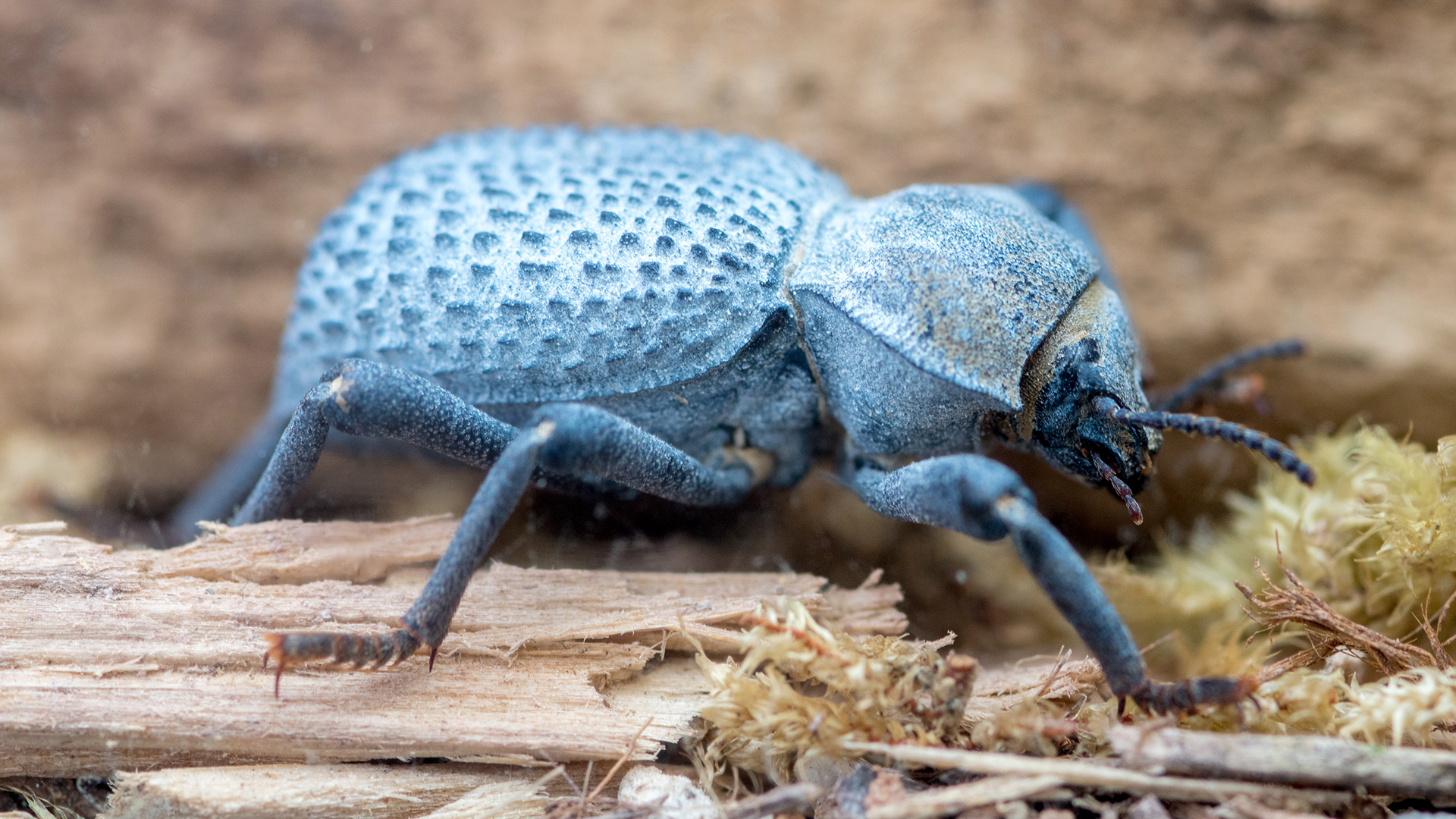
The desert ironclad beetle (Asbolus verrucosus) is a tank of an insect. Its pulverization-blue color comes from a waxy coating that helps the beetle retain moisture in the dry Sonoran desert. The bumps on the beetle's shell give it an armored advent that is fifty-fifty tougher than it looks. The ironclad beetle subfamily is known for its ultra-strong exoskeleton — it's so strong, these beetles can shrug off beingness stepped on by a human, according to the University of Wisconsin, Milwaukee.
Desert ironclad beetles are also known equally "decease-feigning beetles" for their defensive beliefs in the face of threats. When alarmed, the beetles roll over and play expressionless, according to the Cincinnati Zoo and Botanical Garden. They consume plants and decomposable organic matter, and — like many desert citizenry — rarely, if ever, need to drink.
Sand true cat
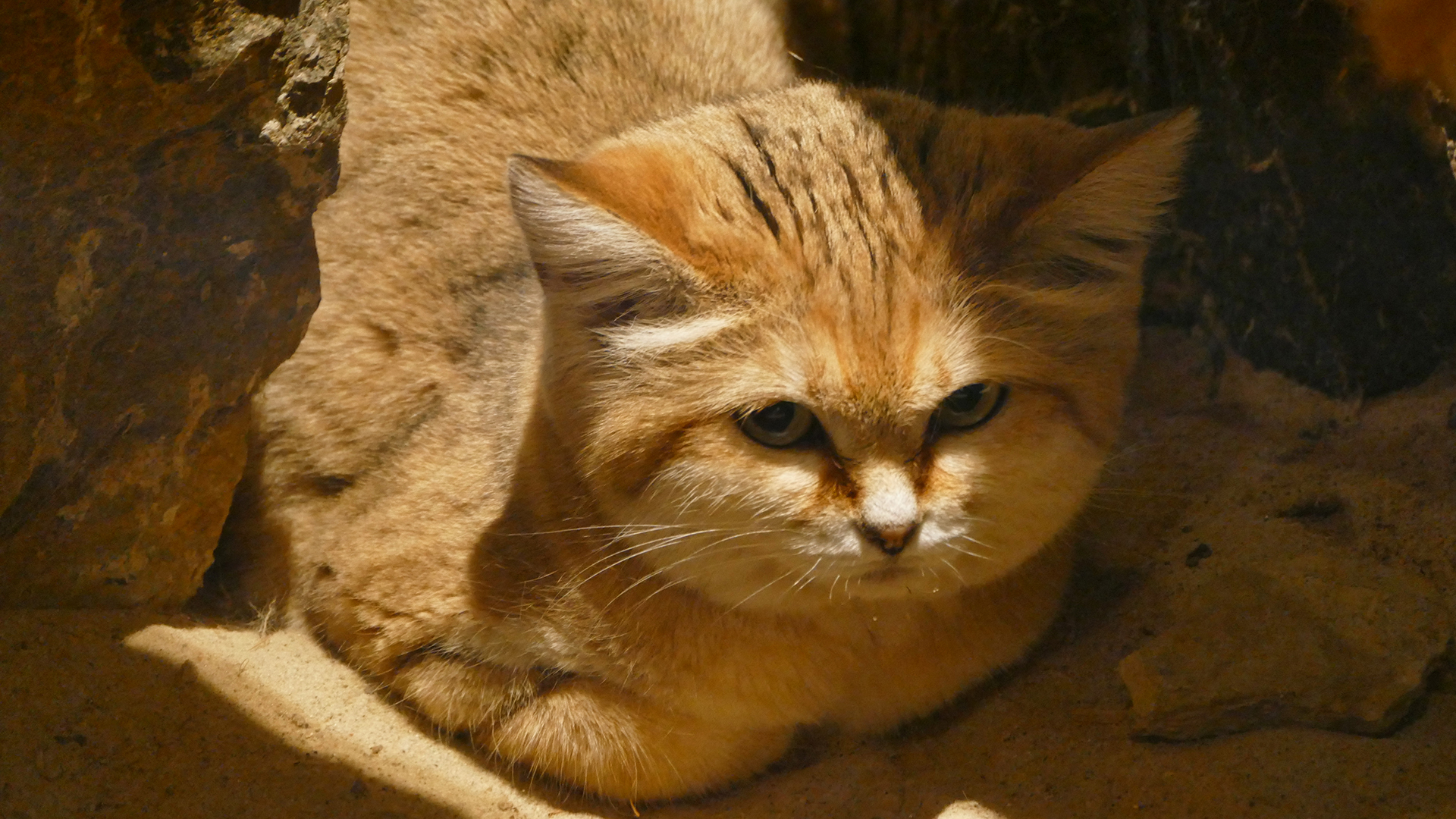
A softer, fuzzier desert denizen is the desert sand cat (Felis margarita). It is the only cat species that makes its home in true desert environments. Desert sand cats are plant in the Sahara desert, the Arabian Peninsula, Turkmenistan, Kazakhstan and Uzbekistan. Though they expect remarkably like to fluffy domestic kitties, sand cats are elusive and rarely seen by people. They're secretive and difficult to track, according to the International Society for Endangered Cats (ISEC) Canada. Researchers who tried to observe these animals in the wild found that the cats' fur-lined paws left no tracks, and their light-colored coats made them challenging to spot. What's more, the cats crouched depression and closed their eyes against searchlights at night, hiding their reflective retinas.
Sand cats are stealthy hunters and are able to kill snakes too as desert rodents and lizards. Their mating phone call sounds similar a dog's bark.
Desert long-eared bat
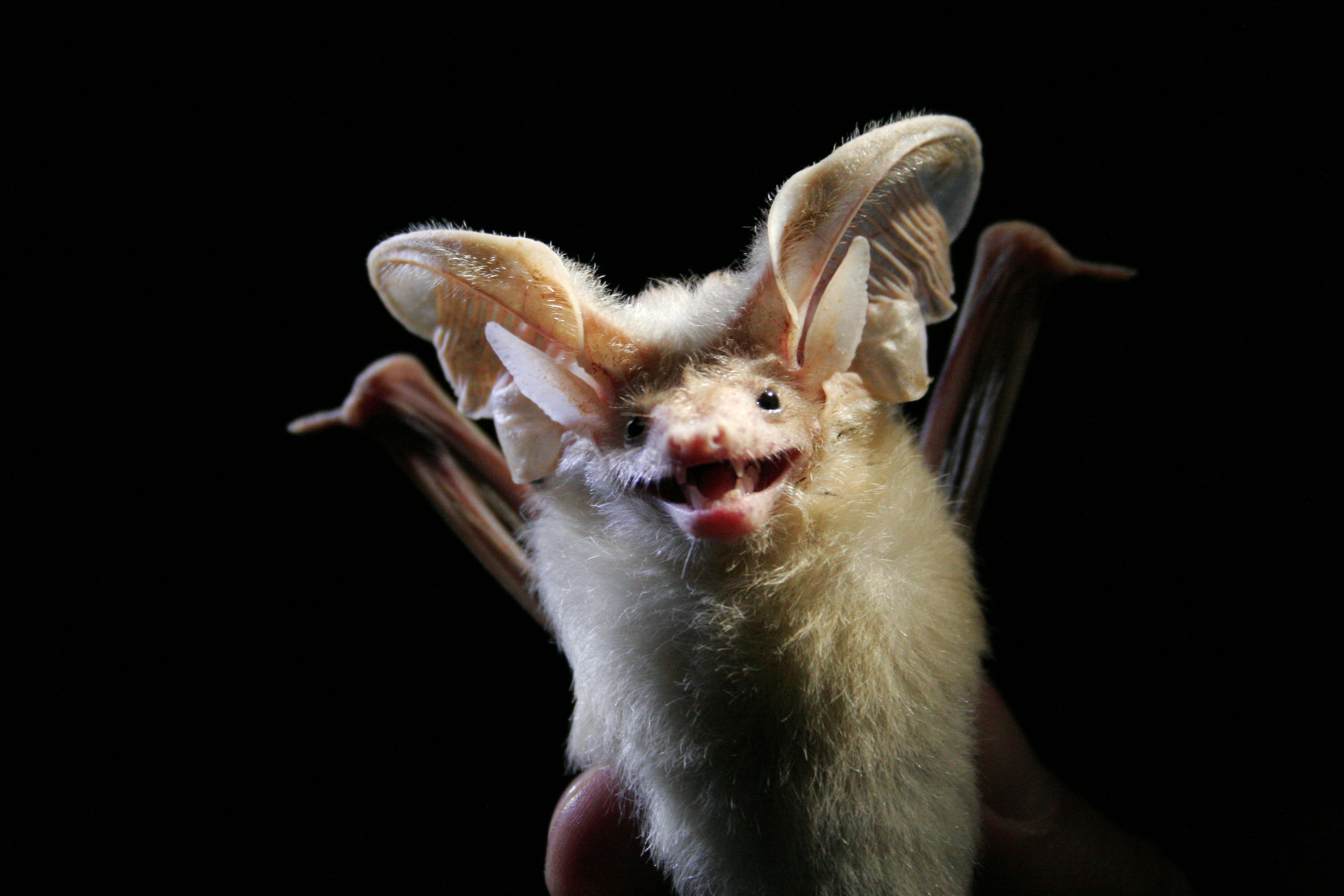
Once dubbed "the hardest bat in the world (opens in new tab)," the desert long-eared bat (Otonycteris hemprichii) is found in North Africa and the Eye East. What earned this bat species that nickname? Well, its primary diet is scorpions.
Desert long-eared bats hunt scorpions by falling onto them out of the sky and wrestling the venomous arachnids into submission. The bats are unbothered by the multiple scorpion stings they often receive in the process, according to research from Ben-Gurion University of the Negev in State of israel. Ben-Gurion University researchers besides constitute that desert long-eared bats can switch the settings on their sonar, using one type of echolocation to seek out ground-home prey like scorpions and some other type to hunt downwards flying insects.
Pink cockatoo
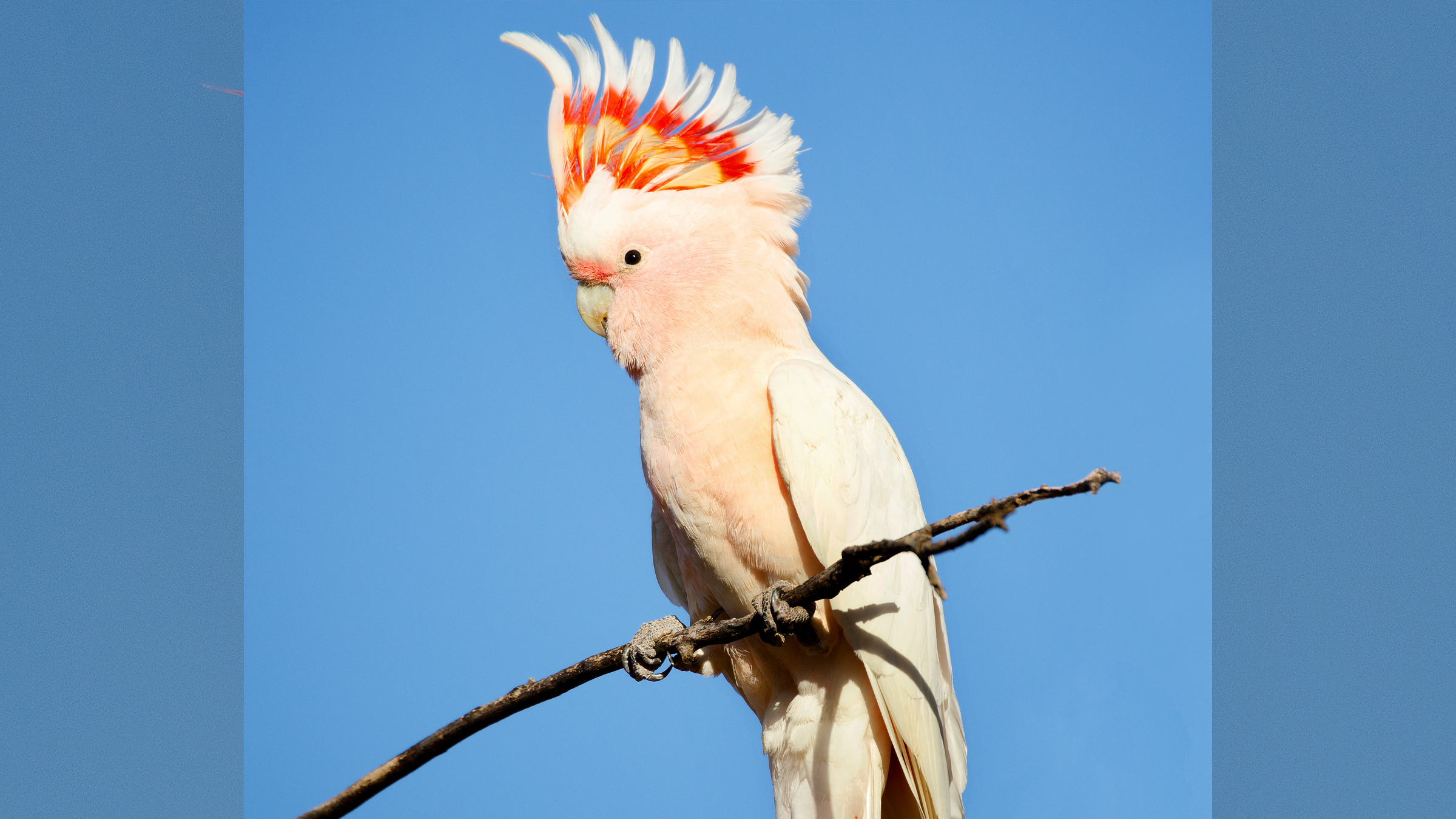
Colorful birds are often plant in lush, tropical rainforests and are scarce in arid regions — except if that region happens to exist in Australia's interior. One of the continent'due south nearly dear bird species is the pink cockatoo (Lophochroa leadbeateri), which ekes out an existence in the semi-arid and barren Australian Outback.
Identifiable past its showy orange-and-yellowish crest and its chroma-shaded body, the pink cockatoo is divided into two subspecies: 1 found in western-central Australia and other in the e, co-ordinate to the Australian Museum. These pretty birds live off seeds and insects. They mate for life, according to the Australian Foundation for National Parks and Wildlife (FNPW), and they can be establish prancing on tree branches, bobbing their heads up and downwards to attract mates.
These iconic Australian birds accept a variety of names and nicknames, according to FNPW. They're also known equally Major Mitchell's cockatoos (subsequently the early on English explorer who wrote well-nigh them for a global audition), as well equally Leadbeater's cockatoos, desert cockatoos, cocklerinas, chockalotts and — adorably — wee jugglers.
Sidewinder
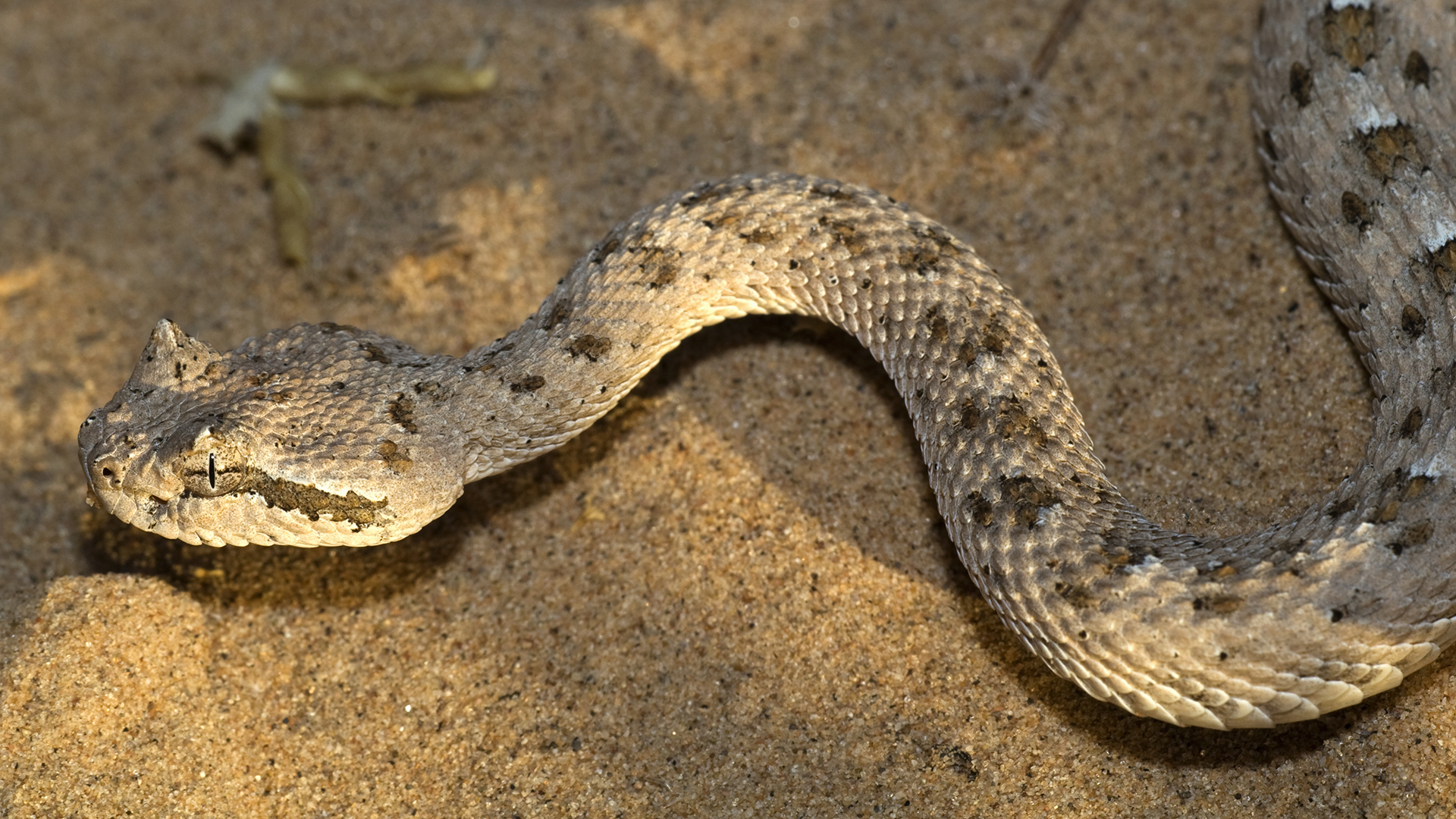
Perhaps zero screams "desert" similar the image of a sidewinder rattlesnake undulating over a sand dune, leaving behind bizarre curved tracks. Sidewinders (Crotalus cerastes) can slither at speeds of up to 18 mph (29 km/h) using their foreign sideways clamber — even across loose sand, according to the Smithsonian Channel.
Sidewinders are ambush hunters. They bury themselves in sand, leaving just their eyes peeking upward. When a cadger happens past, they snap forward and leap the trap. These snakes strike in the glimmer of an eye, injecting venom that ]attacks both the blood and the nervous system of unwary prey.
Sidewinders are institute in the southwestern United states of america and northwestern Mexico. They tin can exist recognized past the protruding horn-like structures shading their eyes, which may go on sand from obscuring their vision.
Desert pupfish
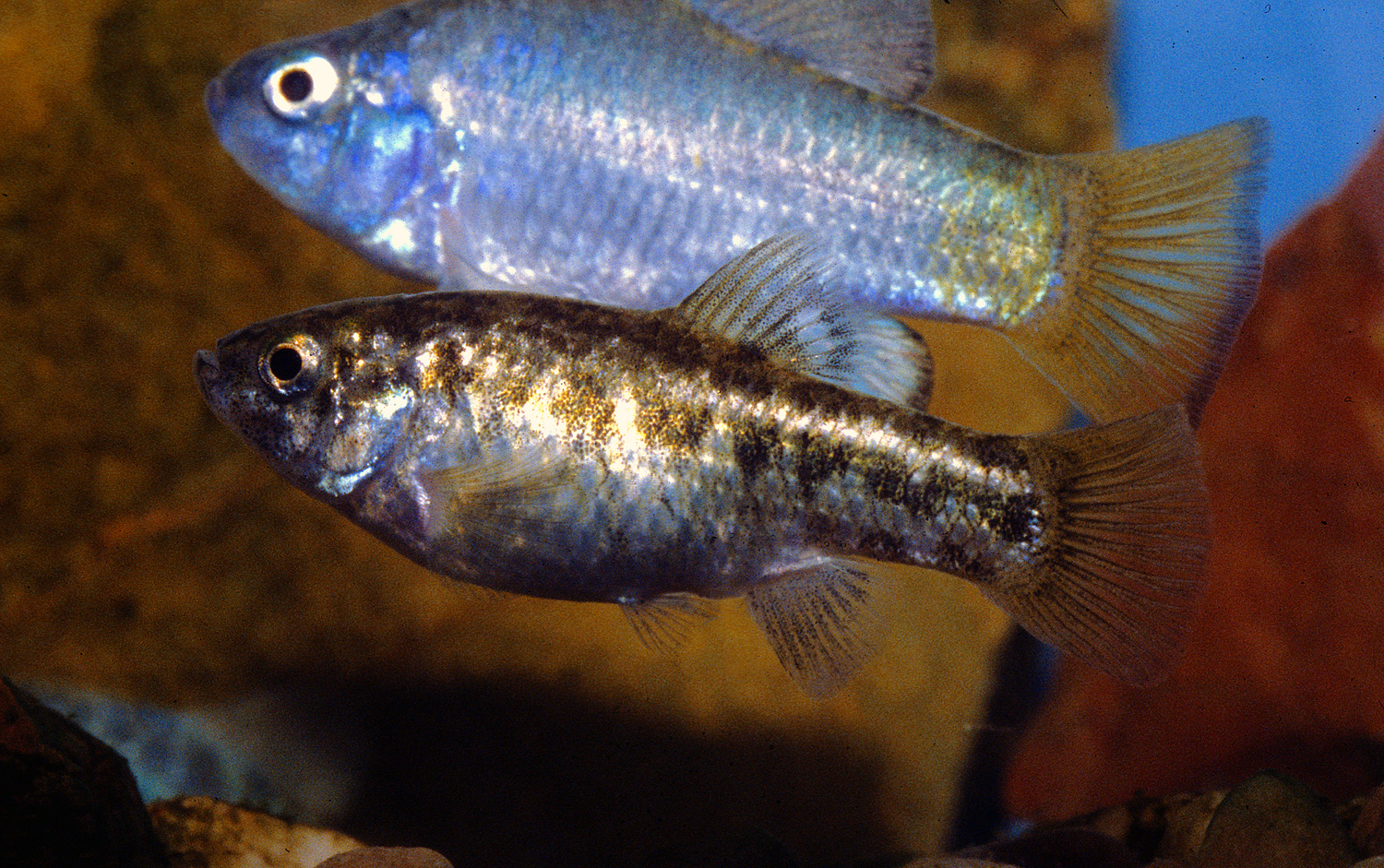
Fish in the desert? Desert pupfish (Cyprinodon macularis) are small, silvery fish that tin survive remarkably well in parched weather. Pupfish accept evolved to thrive in h2o that flows through arid regions. They're plant in California'southward Salton Sea and its tributaries, and in waterways along the lower Colorado River in Mexico.
These fish require a high degree of resiliency to survive in a desert'due south meager or brackish water sources. Special adaptations enable pupfish to survive despite conditions that would be deadly for about fish, according to the California Section of Fish and Wild animals. Pupfish tin live in water ranging from fresh to lxx parts-per-yard salt (near of the ocean is between 34 and 26 parts-per-chiliad common salt). They tin live in water as cold as 40 degrees Fahrenheit (four.4 degrees Celsius) and as hot as 108 degrees F (42.2 C). They tin even live in h2o as poorly oxygenated equally 0.1 parts-per-million (ppm) oxygen (about warm-water fish crave v ppm oxygen in their water to survive, according to Florida'southward Heart for Aquatic and Invasive Plants).
Despite their toughness, desert pupfish are endangered in California, threatened by the introduction of non-native species and habitat loss.
Thorny devil
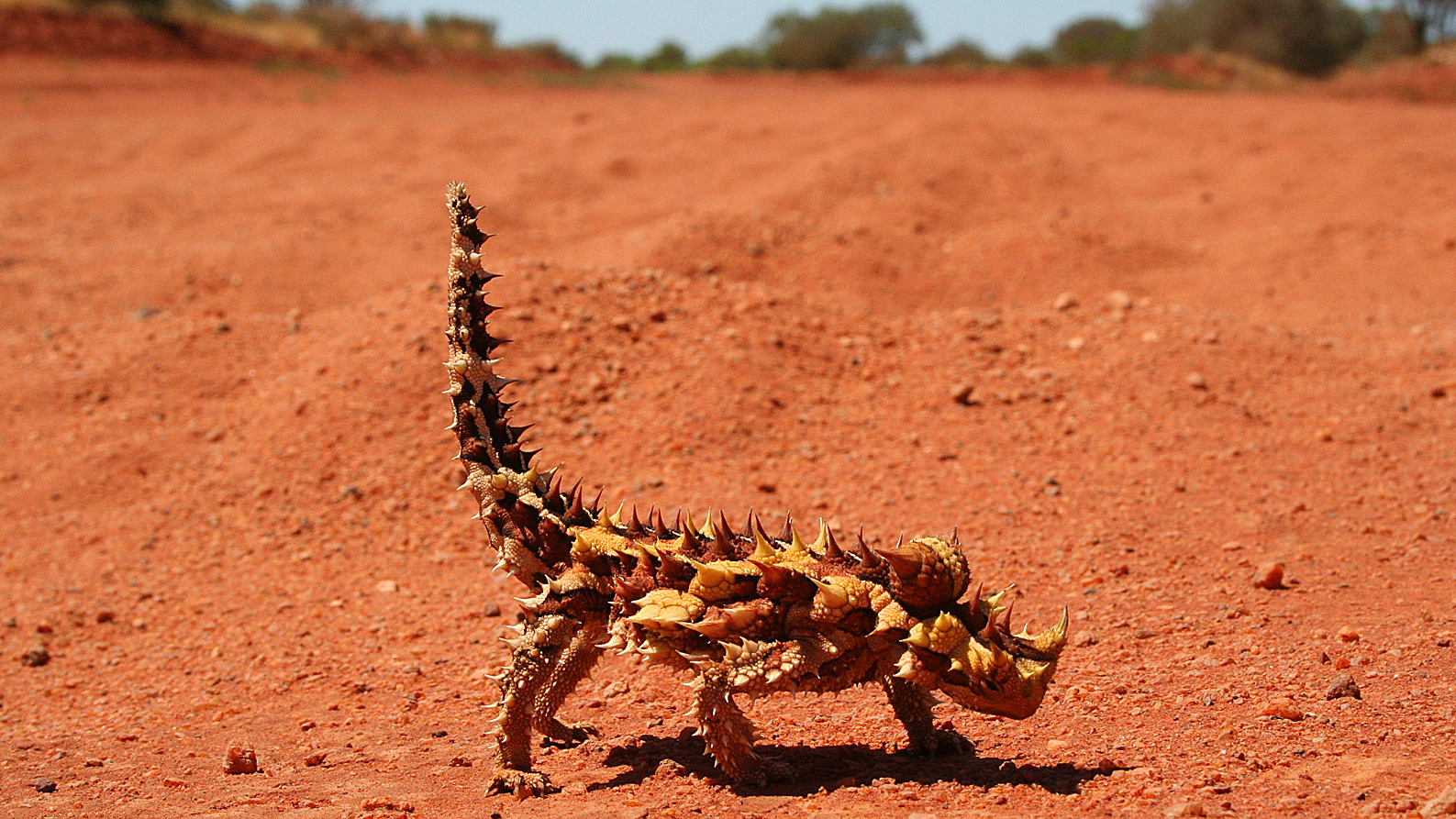
No list of weird desert animals would be complete without a nod to cadger-kind. And no nod to lizard-kind would be complete without mentioning the thorny devil (Moloch horridus), the sole species in the genus Moloch, named for an aboriginal, sacrifice-enervating god worshipped by the Caanites and mentioned in the Hebrew Bible. Thorny devils are only found in Australia. They abound to exist just over 8 inches (21 cm) long from nose to tail and are covered with sharp spines that serve as a defense against predators.
Thorny devils also have two heads — really. One is a faux caput, a protuberance that sits on superlative of the devil's neck. When threatened, a thorny devil will lower its real head, presenting the false head every bit a decoy. Thorny devils too take a distinctive hasty walk that may confuse predators, according to Bush Heritage Australia.
Every bit intimidating as thorny devils may look, they're really only a danger to ants, which they lap upwards by the thousands with their viscid tongues, according to Bush-league Heritage Australia. These desert denizens "drink" through their pare, collecting dew and wet from sand with tiny channels between their scales. These straw-like channels, which direct the precious drops to the lizards' mouths, are only one instance of the creative hydration mechanisms that continue animals alive in the driest places on Globe.
Source: https://www.livescience.com/weird-desert-animals
Posted by: thompsonmorpegir.blogspot.com

0 Response to "What Kind Of Animal Live In The Desert"
Post a Comment